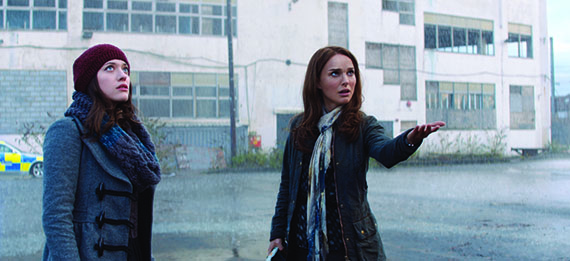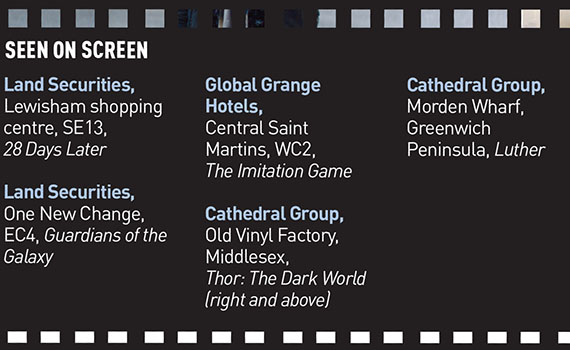The former Central Saint Martins site in Holborn, WC2, is a mecca for film makers. Its spiral stairwells, hidden corners and unusual open spaces serve as the perfect canvas.
The main atrium is where Keira Knightley sat her maths test in The Imitation Game, former classrooms served as the laboratories in the upcoming Frankenstein movie starring Daniel Radcliffe, and today it is set up as a court for the new BBC adaptation of Agatha Christie’s And Then There Were None.
The art college moved to King’s Cross, N1, in 2011 and its Holborn site is now under new ownership and awaiting development. Although it has been vacant for more than four years, the 230,000 sq ft property has been given a new lease of life as one of the most shot film locations in the UK.
According to film and media agency Film London, 75% of the UK film industry is based in and around London, and almost £1bn of the UK’s £1.4bn feature film spend was invested in the capital in 2014.
Location agencies, such as The Collective, search the city for sites that can be used for film production. And this presents an opportunity for landlords – not just to get their assets in the spotlight, but to keep their properties active when they would otherwise be lying empty.
“There has never been a better time for landlords and developers to cash in on this demand for unique location hire,” says James Hanford, The Collective’s acquisition manager.
Tax incentives
The incentive for the film and TV industries to shoot in the UK is clear. Apart from the vast range of locations, producers can also cut costs through a tax credit scheme introduced in 2013. It delivers a 20% rebate for shows that cost more than £1m per hour of screen time to make. Rupert Murdoch’s Fox received £7m from HM Revenue & Customs for shooting 24: Live Another Day in London. Producers have clocked onto this, and with blockbusters like Star Wars hogging studio space, demand in the capital for alternative locations is surging.
But how does the property sector benefit? And what returns can it expect? Unlike most aspects of the film industry, this is less about making big bucks and more about keeping assets stable and protected. This set-up works best where filming brings revenue for sites that are tangled up in planning.
Developer Cathedral Group took advantage of this with its 17-acre Old Vinyl Factory site in Hayes, Middlesex, which hosted the production for 2013 blockbuster Thor: The Dark World.

With sites of this size, it can take up to three years from purchase to getting spades in the ground, and not much can be done to mitigate the costs in the meantime.
“Empty sites need money,” says Cathedral creative director Martyn Evans. “If you have the ability to do it, if the sites are safe and have public access, filming is about the only way you can raise some money.”
In terms of how it usually works, location agencies will scout potential sites and act as the middle man between film companies and landlords. “If a site has got life as a film location, there is no big pressure on landlords to put things through planning as quickly as possible as they are not bleeding money. They can relax a little,” says Collective managing director Antony Iredale.
And he adds that while allowing a property to be used as a film set does not change business and empty rates law, the money you can bring in by opening the doors to a film crew can help to cover these.

But how much money are we talking? Mark Hughes-Webb, who runs London location agency Space 2, estimates that landlords sitting on the right site can make hundreds of thousands of pounds per year through a series of different projects.
“Income comes in the form of a location fee, which will range from between £1,500 to £4,000 a day as a typical fee for TV and film, and more for feature films,” he says.
“The way to make the most money is to maximise the location fee at an industry-sustainable level so that you get repeat business. It is more about seeing it as a steady income stream rather than just a daily fee.”
While there is clearly value to be clawed back that can help to mitigate costs, being a film set does not cover them completely.
“We would not have covered the costs of a 20-acre site by filming alone, but we made a six-figure return from that activity,” says Evans.
In on the act
Another developer known for working with production companies is Land Securities. The REIT has a portfolio of assets which The Collective is promoting for filming, with the sky garden at the Walkie Talkie, 20 Fenchurch Street, EC3, its most recent addition.
LandSec brand partnership manager Richard Isom works with the location agencies and takes care of all filming activity across the portfolio.
“There are certain aspects of our portfolio which would be underutilised if we weren’t filming,” he says. “The right building can generate a six-figure sum annually, and a feature film can make as much as £10,000-£15,000 a day, so there is a clear financial benefit.”
A bit of extra cash is always nice, but financially speaking, filming does not always have the power to boost the value of a landlord’s entire portfolio, or help with long-term business.
“The revenue itself counts towards the valuation of our assets, but in terms of selling more space, I wouldn’t claim that it contributes,” says Isom.
It is not part of The Collective’s objective to help business in this way, either.
“I wouldn’t say that what we do becomes the core part of someone’s business plan,” admits Iredale.
But then the benefits go beyond the cold, hard cash. “It showcases our buildings to a much wider audience,” says LandSec’s Isom. “You can see a building such as 20 Fenchurch Street on screen, which promotes it to tourists and the public. Ultimately, it is about promoting London as a destination.”

Historically, this has worked well. A report by EuroScreen in 2014 revealed that social media mentions of Richard Curtis’s 1999 flick Notting Hill generated the equivalent of £19.5m in online ad spend for the capital, and that the Harry Potter and Sherlock series have netted £10.4m and £10.8m respectively.
It also showed how a location’s association with a film has a lasting legacy. Not only can film immortalise property on screen, but every time it gets a mention in the press or online, chances are the film it featured in will be referenced too.
King’s Cross Station will never be able to shake off its Harry Potter connection, and the Millennium Dome will forever be linked with Piers Brosnan’s boat chase at the start of the 1999 Bond movie The World is Not Enough.
Community benefits
And it is not just about getting your asset out there for everyone to see. Getting involved with film and TV can give landlords an opportunity to engage with the local community and boost the profile of the local area. Film productions that use a property for long-term projects also support local businesses.
“Production companies are getting wise to the fact that they can raise the profile of an area and it doesn’t cost much,” says Hughes-Webb. “Landlords can then use that to support planning briefs, highlighting benefits to the local economy, as well as the creative sector.”
To do all of this successfully, landlords need some assistance along the way. In the wrong hands, working with film producers can be a frustrating process. This is where location agencies step into the frame.
“Location enquiries usually fall onto the desk of someone who has no idea about filming, their bonus is not wrapped around filming revenue, they are probably already overworked, and then they are told to go and deal with an industry that can sometimes be a real pain,” says The Collective’s Iredale.
After Cathedral Group bought the Old Vinyl Factory in 2011, The Collective got in touch with film makers, having worked with the previous owner of the site on similar projects. But it is not just a case of negotiating a fee.
Evans says: “You can’t just give them a key, go away and hope they will be OK, you have to set yourself up to be able to manage it properly. Film crews can be quite demanding, so you really need to have somebody who is there on site looking after your interests.”
 Sitting on a goldmine?
Sitting on a goldmine?
Some landlords might have no idea that they are sitting on a perfect film set. Producers are clamouring to get their hands on what some would think of as secondary or back-of-house areas such as rooftops or underground car parks. Blank sites work well and can be dressed up to a producer’s needs. In an empty warehouse they can build sets, have car chases and blow things up, and there aren’t many places where you can do those sorts of things in London.
“Large warehouses, vacant offices, empty schools and empty institutional buildings are what we look for. If it is empty then you can increase the value fivefold because you are not reliant on having to go at weekends,” says Iredale.
The other advantage to an empty site is that there is no one to disturb. Filming in operational buildings, such as 20 Fenchurch Street, is limited to weekends and evenings, which is not always convenient.
“We always make sure that filming has minimal disruption to the buildings,” says Isom. “Once a site is operational, there are also extra safety issues to consider.”
Iredale adds: “The film industry is like any other industry; if they can avoid working weekends, they will.”
The opportunity is there, the only obstacle is getting landlords to open their doors.
The former Central Saint Martins site is an example of how this set up can work so well. The Collective brings business through the door, and all the landlord has to do is sign on the dotted line and take its fee until the diggers eventually arrive on site.
As the BBC brings filming for And Then There Were None to a close, the crew packs up its murder scenes to make way for the next film. And as with most projects at this site, the only evidence that they were there will be the finished product.











